Why you can trust Tom's Hardware
Our standard benchmarks and power tests are performed using the CPU’s stock frequencies (including any default boost/turbo), with all power-saving features enabled. We set optimized defaults in the BIOS and the memory by enabling the XMP profile. For this baseline testing, the Windows power scheme is set to Balanced (default), so the PC idles appropriately.
To get the most out of the Intel Alder Lake chips, you need to be on Windows 11 with its updated scheduler. In most cases, Windows 10 performs well. However, some tests (Cinebench R20, Corona and POVRay) take a significant hit. In short, if you’re going with Alder Lake, you must upgrade to Windows 11 for the best results across the board. That may change with patching and updates in the future, though.
Synthetic Benchmarks
Synthetics provide a great way to determine how a board runs, as identical settings should produce similar performance results. Turbo boost wattage and advanced memory timings are places where motherboard makers can still optimize for either stability or performance, though, and those settings can impact some testing.






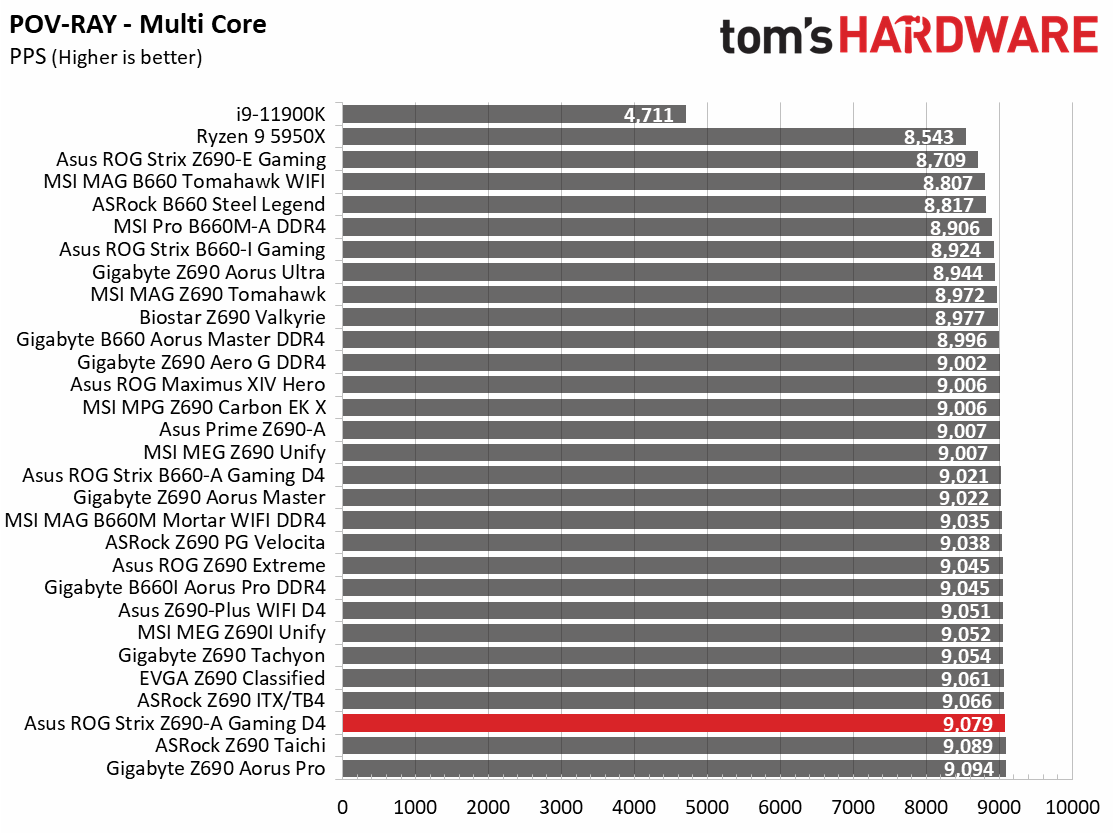


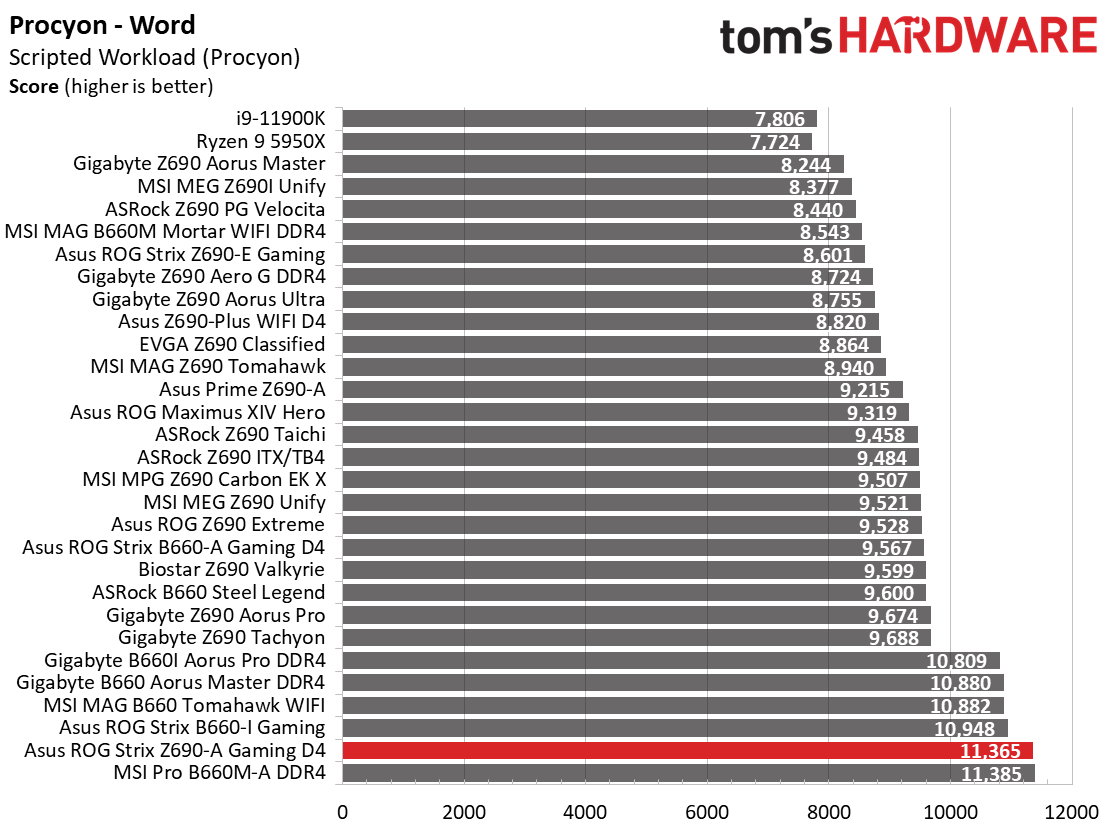






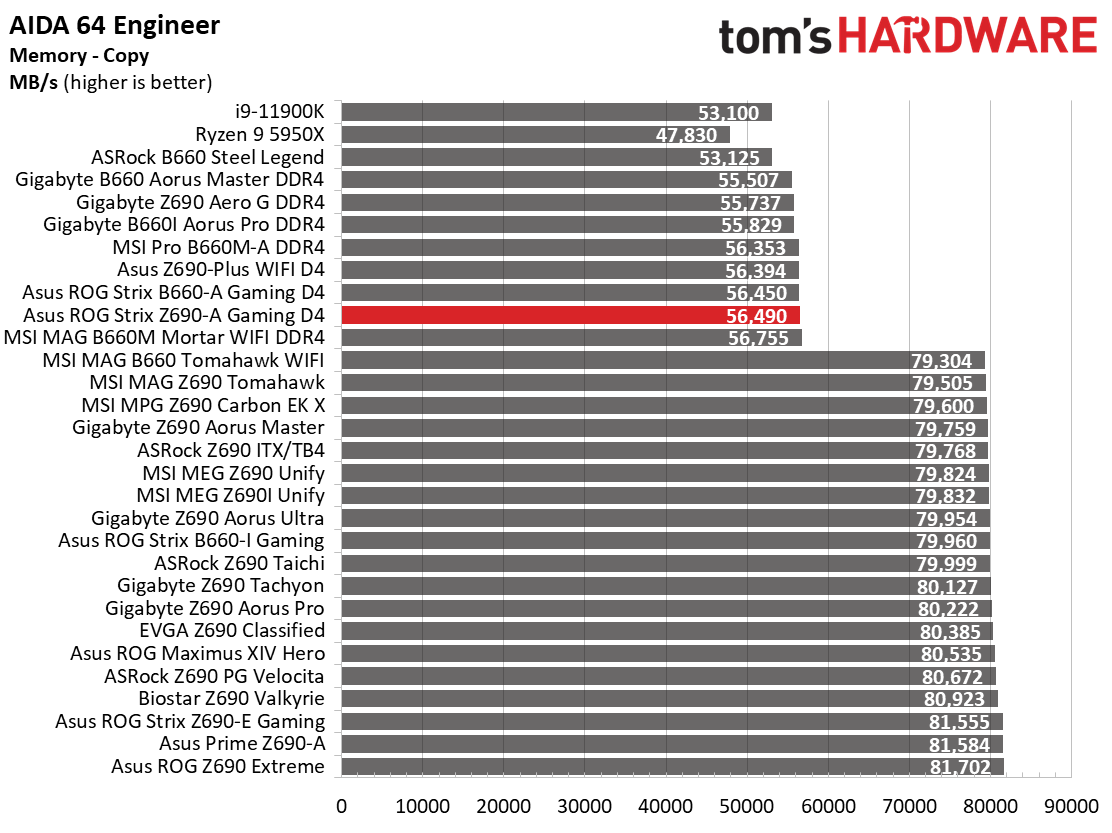

Results from our synthetic benchmarks were average to above average for DDR4-based boards. 7Zip, Cinebennch, Blender, POV-Ray and Procyon Office all showed above-average results (the rest were average) overall, where DDR4 wasn’t limiting things. Since the CPU doesn’t throttle in heavily multi-threaded applications at default, we saw great results across these tests.
Timed Applications




In our timed applications, the Z690-A also did well overall, showing good results in LAME and Corona, matching the fastest times we’ve recorded. Handbrake was a tale of the two tests where x264 was slightly slower than average and the x265 was one of our faster results. We don’t have any performance concerns in the timed applications either.
3D Games and 3DMark
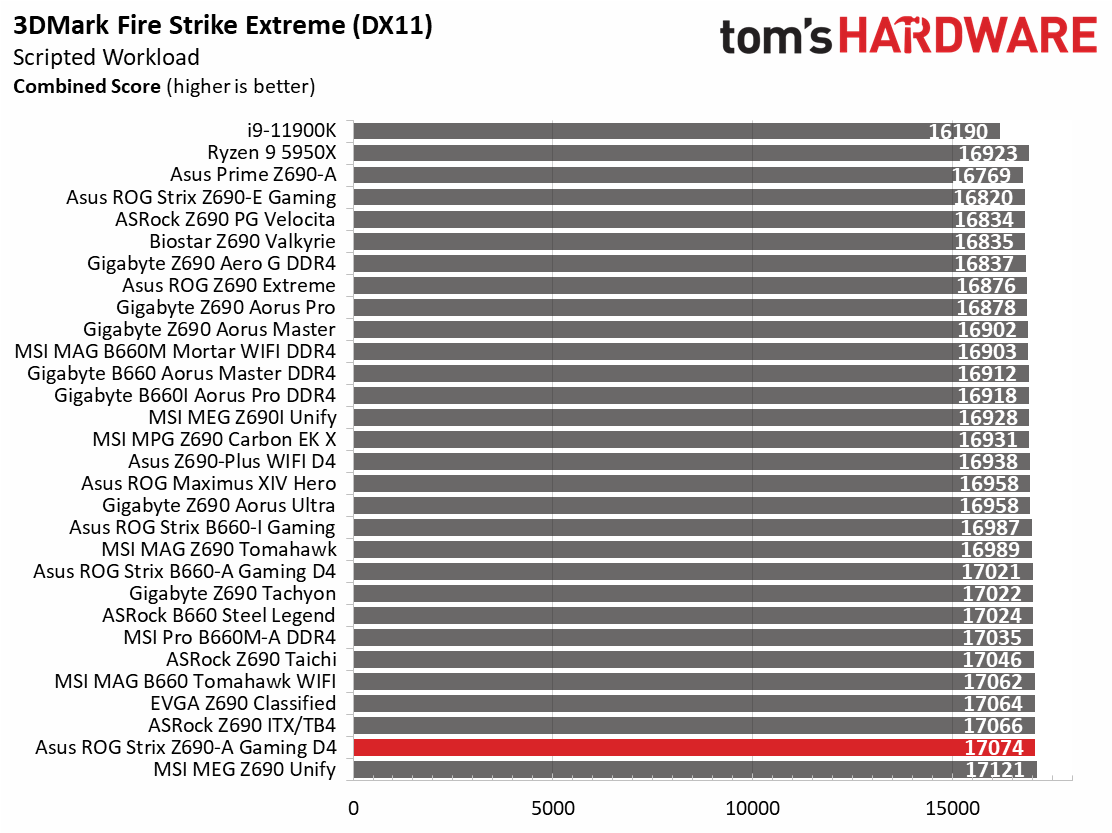
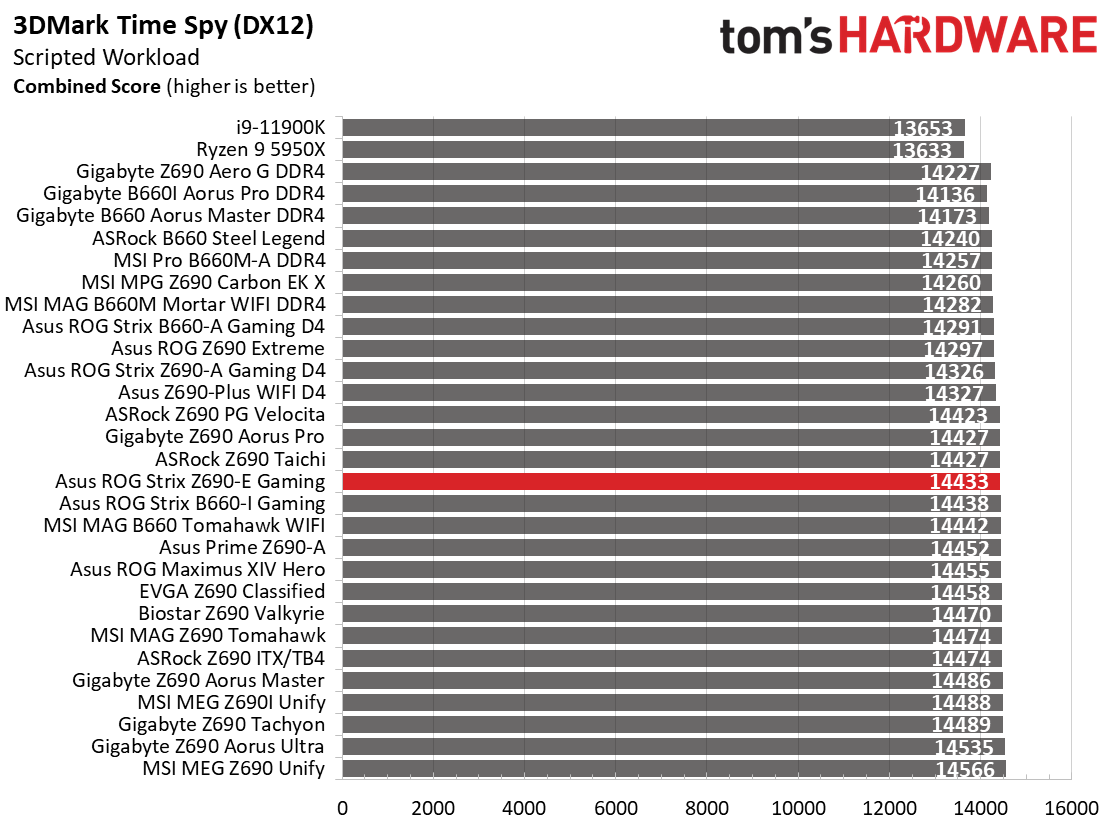


Starting with the launch of the Z690 chipset, we’ve updated our game tests, switching to Far Cry 6 and shifting from F1 2020 to F1 2021. We run the games at 1920x1080 resolution using the Ultra preset (details listed above). As the resolution goes up, the CPU tends to have less impact. The goal with these settings is to determine if there are differences in performance at the most commonly used resolution with settings most people use or strive for. We expect the difference between boards in these tests to be minor, with most falling within the margin of error differences. We’ve also added a minimum FPS value, as that can affect your gameplay and immersion experience.
In F1 2021, the Z690-A Gaming reached 165 frames per second (fps) with minimums of 139 fps, an average result. In Far Cry 6, results were also average at 137 fps, with the minimum at 125 fps, which is also average. In the synthetic benchmarks, the board scored 14,433 in Time Spy, which is dead on average, while the 17,074 score in Fire Strike Extreme is the second fastest. This board is just as capable of a gaming machine as the others.
Get Tom's Hardware's best news and in-depth reviews, straight to your inbox.
Power Consumption / VRM Temperatures
We used AIDA64’s System Stability Test with Stress CPU, FPU and Cache enabled for power testing, using the peak power consumption value. The wattage reading is from the wall via a Kill-A-Watt meter to capture the entire PC minus the monitor. The only variable that changes is the motherboard; all other parts are the same.
At idle, the Z690-A Gaming used 52W, which is on the good side of average among similar Z690 boards (the average of all Alder Lake-based boards is 61W). Load wattage peaked at 320W, which is also slightly better than the average of 325W for all boards. There’s nothing out of line when it comes to power consumption here.


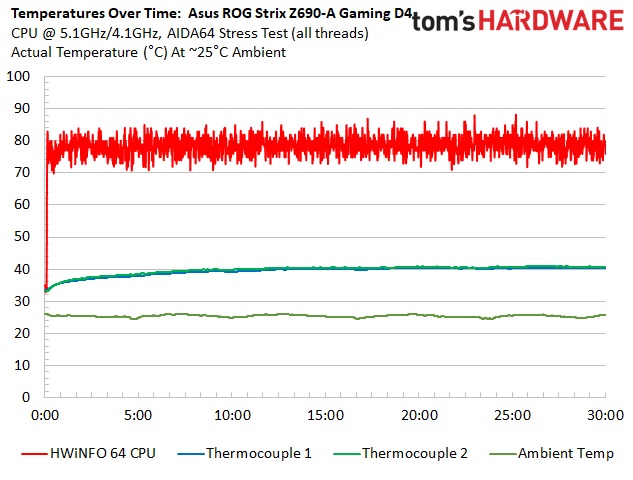

VRM temperatures were nice and cool during stock testing, peaking around 50 degrees Celsius. Through the testing, there was some minor thermal throttling. When we overclocked and set the voltage manually, the VRMs ran slightly cooler, peaking at 49 degrees Celsius. Power delivery temperatures are not a concern as you’ll be limited by the CPU temperatures before the VRMs prevent progress.
Overclocking
Overclocking with Alder Lake is slightly different from what we’re used to due to the hybrid core configuration. Now, you can overclock the P and E cores separately, though they both use the same voltage domain. You can push one and not the other, or both, so there’s some flexibility. We set an overclock to 5.1 GHz across all P-cores and 4.1Ghz on all E-cores. This yields a 200 MHz bump on the P-cores and a 400 MHz increase on the E-cores. We’re topped out on the P-cores, primarily due to temperatures, but the more efficient E-cores still have some headroom.
Overclocking our Intel Core i9-12900K with the Z690-A Gaming proved relatively painless. We manually set our voltage to 1.25V and used Asus’ recommended Load Line Calibration (LLC4), but the system froze almost instantly after starting the stress test. I couldn’t record the amount of vdroop, but whatever voltage the processor received was less than the ~1.25V we need to be stable at these clocks. Setting LLC7 yielded no vdroop and a stable overclock.
On the memory side, we dropped our GSkill DDR4-4000 sticks in, enabled XMP, and off we went without issue. Of course, the middling DDR4-3600 kit worked fine for our testing too. We suspect there’s still some headroom left, as Asus lists support to well over these value-focused speeds.
Bottom Line
Asus’ ROG Strix Z690-A Gaming WIFI D4 is a good motherboard overall. It performed very well across our testing suite,posting some of the highest scores and fastest times we’ve seen. It played our games well and power use wasn’t out of line. It’s not all about performance, though. The four M.2 sockets and six SATA ports offer plenty of storage capability, and there are more than enough USB ports (including 20 Gbps Type–C) on the rear IO. On the networking side, the 2.5 GbE and integrated Wi-Fi 6 are fast enough for most users. For those who want to overclock, the 80A VRMs don’t flinch. On top of that, the cool RGB lighting and unique-to-ROG silver-on-black aesthetic looks good, too.
Among Z690 DDR4 boards, the Z690-A Gaming WIFI D4 is one of the most expensive on Newegg, at $322.99. Gigabyte’s Z690 Aero G is $259.99, while the MSI MPG Z690 Edge WIFI DDR4 is $279.99. ASRock’s most expensive DDR4 board is the Z690 Extreme at $196.99. The latter is a board that punches above its weight class (review coming soon). The three less expensive boards offer similar hardware configurations, including six SATA ports, four M.2 sockets, 2.5 GbE, Wi-Fi 6, and the premium Realtek ALC4080 audio codec. Of course, there are differences in power delivery too, but each supports an i9-12900KS when overclocked, so that doesn’t play a significant role.
Price be damned, it comes down to appearance between these similarly equipped boards. If you want black, it’s ASRock or MSI. Silver, it’s the Asus or Gigabyte. If you want to save significant money, ASRock’s Z690 Extreme fits that bill with very few sacrifices (last-gen flagship audio, three M.2 sockets) to get there. In fact, it’s the only board with Wi-Fi 6E and eight SATA ports out of this group. In the end, the Asus Z690-A Gaming WIFI D4 is a competent DDR4 motherboard, but more expensive than its similar competition. Its performance and well-rounded specifications are attractive as is the unique (for ROG) appearance. And while it’s the cheapest way into a high-quality ROG-brand board, there are less expensive and similarly appointed options available.
MORE: Best Motherboards
MORE: How To Choose A Motherboard
MORE: All Motherboard Content

Joe Shields is a staff writer at Tom’s Hardware. He reviews motherboards and PC components.
-
-Fran- It's a beautiful board, for sure. I like white accents on boards, more than other colours... I don't know why.Reply
Other than that, bog standard board? Slightly higher priced than the competition, but I guess they can justify it with their software.
Regards.

